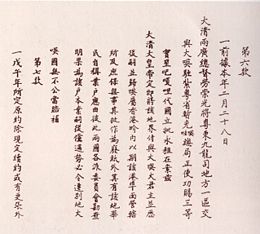Convention of Peking
Convention of Peking
|
|||||||||||
|---|---|---|---|---|---|---|---|---|---|---|---|
| Traditional Chinese: | 北京條約 | ||||||||||
|
|||||||||||
The Convention of Peking or the First Convention of Peking is the name used for three different treaties, which were concluded between Qing China and the United Kingdom, France, and Russia.
Contents |
Background
On 18 October 1860, at the culmination of the Second Opium War, the British and French troops entered the Forbidden City in Beijing. Following the decisive defeat of the Chinese, Prince Gong was compelled to sign two treaties on behalf of the Qing government with Lord Elgin and Baron Gros, who represented Britain and France respectively.[1] Although Russia had not been a belligerent, Prince Gong also signed a treaty with Nikolay Muravyov-Amursky.
The original plan was to burn down the Forbidden City as punishment for the mistreatment of European prisoners by Qing officials. Because doing so would jeopardize the treaty signing, the plan shifted to burning the Emperor's garden estates of Qīngyī Yuán and Yuánmíng Yuán instead.[1] The treaties with France and Britain were signed in the Ministry of Rites building immediately south of the Forbidden City on 24 October 1860. [2]
Terms

The area known as Kowloon was originally leased in March 1860. The Convention of Peking ended the lease, and ceded the land formally to the British on 24 October 1860.[3]
Article 6 of the Convention between China and the United Kingdom stipulated that China was to cede the part of Kowloon Peninsula south of present day Boundary Street, Kowloon, and Hong Kong (including Stonecutters Island) in perpetuity to Britain.
The treaty also ceded parts of Outer Manchuria to the Russian Empire. It granted Russia the right to the Ussuri krai, a part of the modern day Primorye, the territory that corresponded with the ancient Manchu province of East Tartary. See Treaty of Aigun (1858), Treaty of Nerchinsk (1689) and Russian-Manchu border conflicts. The treaty is considered one of the unequal Treaties.
Aftermath
The governments of the United Kingdom and the People's Republic of China (PRC) concluded the Sino-British Joint Declaration on the Question of Hong Kong in 1984, under which the sovereignty of the leased territories, together with Hong Kong Island, ceded under the Treaty of Nanking (1842), and Kowloon (south of Boundary Street), was scheduled to be transferred to the PRC on 1 July 1997.
External links
References
- ↑ 1.0 1.1 1.2 Harris, David. Van Slyke, Lyman P. [2000] (2000). Of Battle and Beauty: Felice Beato's Photographs of China. University of California Press. ISBN 0899511007
- ↑ Naquin, Susan. [2000] (2000). Peking: Temples and City Life, 1400-1900. University of California Press. ISBN 0520219910
- ↑ Endacott, George Beer. Carroll, John M. [2005] (2005). A Biographical Sketch-book of Early Hong Kong. HK University press. ISBN 9622097421
See also
- Second Convention of Peking
- History of Hong Kong
- Imperialism in Asia
